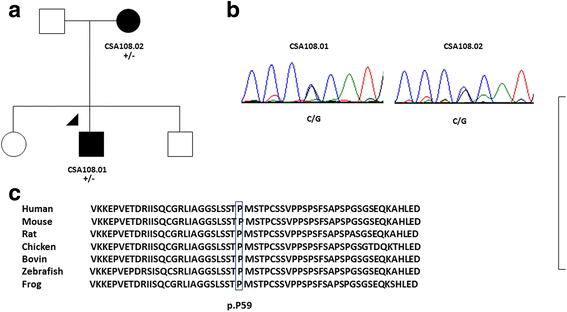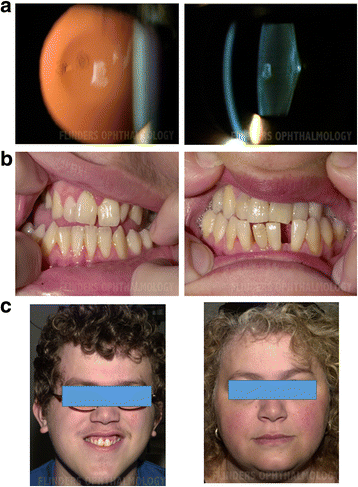Novel missense mutation in the bZIP transcription factor, MAF, associated with congenital cataract, developmental delay, seizures and hearing loss (Aymé-Gripp syndrome)
- PMID: 28482824
- PMCID: PMC5422868
- DOI: 10.1186/s12881-017-0414-7
Novel missense mutation in the bZIP transcription factor, MAF, associated with congenital cataract, developmental delay, seizures and hearing loss (Aymé-Gripp syndrome)
Abstract
Background: Cataract is a major cause of severe visual impairment in childhood. The purpose of this study was to determine the genetic cause of syndromic congenital cataract in an Australian mother and son.
Method: Fifty-one genes associated with congenital cataract were sequenced in the proband using a custom Ampliseq library on the Ion Torrent Personal Genome Machine (PGM). Reads were aligned against the human genome (hg19) and variants were annotated. Variants were prioritised for validation by Sanger sequencing if they were novel, rare or previously reported to be associated with paediatric cataract and were predicted to be protein changing. Variants were assessed for segregation with the phenotype in the affected mother.
Result: A novel likely pathogenic variant was identified in the transactivation domain of the MAF gene (c.176C > G, p.(Pro59Arg)) in the proband and his affected mother., but was absent in 326 unrelated controls and absent from public variant databases.
Conclusion: The MAF variant is the likely cause of the congenital cataract, Asperger syndrome, seizures, hearing loss and facial characteristics in the proband, providinga diagnosis of Aymé-Gripp syndrome for the family.
Keywords: Aymé-Gripp syndrome; Congenital cataract; Ion Ampliseq; MAF; Next generation sequencing; Pediatric cataract; Syndromic cataract.
Figures



Similar articles
-
Recurrent mutation in the crystallin alpha A gene associated with inherited paediatric cataract.BMC Res Notes. 2016 Feb 11;9:83. doi: 10.1186/s13104-016-1890-0. BMC Res Notes. 2016. PMID: 26867756 Free PMC article.
-
Maternally inherited MAF variant associated with variable expression of Aymé-Gripp syndrome.Am J Med Genet A. 2019 Nov;179(11):2233-2236. doi: 10.1002/ajmg.a.61299. Epub 2019 Aug 7. Am J Med Genet A. 2019. PMID: 31390148
-
A novel MAF missense mutation leads to congenital nuclear cataract by impacting the transactivation of crystallin and noncrystallin genes.Gene. 2019 Apr 15;692:113-118. doi: 10.1016/j.gene.2019.01.011. Epub 2019 Jan 17. Gene. 2019. PMID: 30659945
-
Massive pericardial effusion in an infant with Aymé-Gripp syndrome: A case report and review of the literature.Am J Med Genet A. 2024 Sep;194(9):e63586. doi: 10.1002/ajmg.a.63586. Epub 2024 May 6. Am J Med Genet A. 2024. PMID: 38709155 Review.
-
Mutation update of transcription factor genes FOXE3, HSF4, MAF, and PITX3 causing cataracts and other developmental ocular defects.Hum Mutat. 2018 Apr;39(4):471-494. doi: 10.1002/humu.23395. Epub 2018 Jan 16. Hum Mutat. 2018. PMID: 29314435 Free PMC article. Review.
Cited by
-
Exploring Large MAF Transcription Factors: Functions, Pathology, and Mouse Models with Point Mutations.Genes (Basel). 2023 Sep 27;14(10):1883. doi: 10.3390/genes14101883. Genes (Basel). 2023. PMID: 37895232 Free PMC article. Review.
-
Deciphering the association of intronic single nucleotide polymorphisms of crystallin gene family with congenital cataract.Indian J Ophthalmol. 2021 Aug;69(8):2064-2070. doi: 10.4103/ijo.IJO_3062_20. Indian J Ophthalmol. 2021. PMID: 34304179 Free PMC article.
-
Multicentric Carpotarsal Osteolysis: a Contemporary Perspective on the Unique Skeletal Phenotype.Curr Osteoporos Rep. 2023 Feb;21(1):85-94. doi: 10.1007/s11914-022-00762-7. Epub 2022 Dec 7. Curr Osteoporos Rep. 2023. PMID: 36477366 Free PMC article. Review.
-
Novel cataract-causing variant c.177dupC in c-MAF regulates the expression of crystallin genes for cell apoptosis via a mitochondria-dependent pathway.Mol Genet Genomics. 2023 Mar;298(2):495-506. doi: 10.1007/s00438-022-01982-3. Epub 2023 Jan 31. Mol Genet Genomics. 2023. PMID: 36719481
-
MAFB shapes human monocyte-derived macrophage response to SARS-CoV-2 and controls severe COVID-19 biomarker expression.JCI Insight. 2023 Dec 22;8(24):e172862. doi: 10.1172/jci.insight.172862. JCI Insight. 2023. PMID: 37917179 Free PMC article.
References
Publication types
MeSH terms
Substances
LinkOut - more resources
Full Text Sources
Other Literature Sources
Medical

